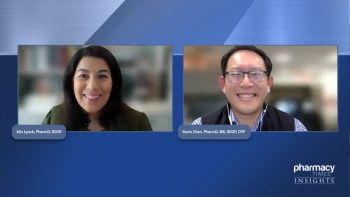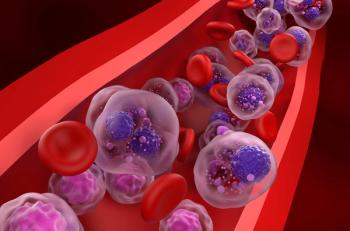
First-Line Treatment Options and Genetic Mutations
Cole McCoy, PharmD, and Dr James McCloskey explain first-line treatment options for different types of AML, how genetic mutation affect treatment decisions, and the treatment option for patients with AML that are unfit for intensive chemotherapy.
Episodes in this series

Ryan Haumschild, PharmD, MS, MBA: When we build out our treatment pathways and our order sets, we're always trying to be thoughtful of different parameters. Making sure we're checking any type of dose reductions or monitoring that's needed becomes an important piece of care, especially for the first-line patients, as well as some of these patients that are newly diagnosed where they’re high-risk or secondary patients. Dr. McCloskey, you can talk about some of the most appropriate treatment options for the high-risk or secondary AML patients according to guidelines?
James McCloskey, MD: Patients with high-risk AML, sometimes referred to as secondary AML—which encompasses patients who have AML that arose in the context of a preexisting hematologic malignancy or developed AML after exposure to chemotherapy or radiation—are some of the most challenging patients to treat because they have a poor prognosis. They come to us with other baggage, some of which we gave them by giving them chemotherapy and having them survive their first malignancy. This is one of the most challenging patients to see and support emotionally. They've made it through one malignancy, only now to be told that they have a serious blood cancer that may have evolved because of their prior exposure. We have made improvements for these patients. The first thing is to go back to the fact that, for patients who are eligible for intensive induction therapy and are under the age of 70, we have good, randomized data to support a selection of treatment for those patients, and that would be liposomal daunorubicin cytarabine. In the randomized phase 3 clinical trial, we showed that treatment with [daunorubicin cytarabine], compared with conventional 7+3, resulted in improved survival. We saw improved remission rates and improved success in taking those patients to transplant, which we think of as still the most likely cure for those patients. Lastly, [there were] better outcomes in patients who went to transplant, who are treated with [daunorubicin cytarabine] compared with 7+3. With that in mind for intensive chemotherapy candidates, [daunorubicin cytarabine] is a category 1 endorsement for the NCCN [National Comprehensive Care Network]. That's our standard for those patients. In that same context, we're evaluating those patients for transplant along the way, and if appropriate, they'll go on to transplant or transition to maintenance after they finish consolidations. For people who are not fit for induction therapy, for whatever reason, or who elect not to go to transplant and not to go on to receive induction therapy, [they] would go on to venetoclax and HMA [hypomethylating agents] for us.
Ryan Haumschild, PharmD, MS, MBA: That was a great overview; a lot of what you said really resonated with me. Speaking to the outcomes and having that data drive the decision is so important. We talked about data-driven decisions, so let's pivot and talk about genetics-driven decisions. When you think about these patient populations, how did genetic mutations affect your treatment decisions, and what are some of the treatment options that might have been mentioned ahead of time that you consider for a unique genetic makeup of a person?
James McCloskey, MD: Before we get to the new and exciting stuff, I would like to touch upon the stuff we know. They've been there for a while. First, cytogenetics and molecular data help us identify favorable risk AML, and that would include your core binding factor leukemias, patients with inversion (inv) (16) and translocation (t) (8;21), folks with NPM1 mutations or biallelic CEBPA mutations without other cytogenetic abnormalities. These people have favorable risk disease. There are patients who benefit from additional induction and consolidation and don't require a stem cell transplant in first remission. Otherwise, we've touched upon a variety of these targeted agents that are important to consider. Some of them are easy to get to. We've already mentioned midostaurin and gilteritinib. The IDH1 and -2 inhibitors are important for patients in the relapsed/refractory setting on occasion, even for consideration as first-line therapy; with the incorporation of venetoclax, I think that's fallen a bit by the wayside. We still use some of those mutational profiles to help assess our appetite for chemotherapy in those patients. The last mutation I've mentioned is sort of the very ominous TP53 mutation, which is not necessarily part of our standard risk-stratification calculators and techniques but is important to consider. We know these are some of the most refractory patients and carry a significant risk for relapse. For patients with a P53 mutation, [we] approach their treatment, acknowledging that we don't know the true standard of care for those patients. We need to acknowledge the limitations for treating their disease: their personal values, goals of treatment, and [if there is a clinical trial].
Ryan Haumschild, PharmD, MS, MBA: I like how you brought it back to the patient decision-making, kind of building off what we talked about. A lot of options still available, but [we need to] recognize the value of clinical trials because that's how a lot of these agents came forward, as we had a chance to enroll these patients. The more we can continue to make sure we're screening for the right side of genetics, the better we can match therapy and provide the better outcome. I always wonder about those patients that are unfit, and we talked about some of those key factors. Danielle, you can talk to us? What is the typical treatment pathway for a patient that's unfit for intensive chemotherapy?
Danielle Marcotulli, APN, RN, MSN, FNP-BC, AOCNP: Typically, we're doing an office-based chemotherapy regimen. They're coming in frequently to see us, and we're usually using decitabine or azacitidine, and now the addition of venetoclax. As Dr. McCoy was talking about earlier, the survival benefits by adding venetoclax are impressive. Most patients are going on that as an outpatient regimen. It's also important to screen some of these patients for appropriate clinical trials that they may be eligible for. That's in the back of our heads, too.
Ryan Haumschild, PharmD, MS, MBA: It’s nice to have options for the patients, and I know some of those patients taking oral medication is a huge win if that provides that convenience for them. I appreciate you bringing that into the conversation.
This transcript has been edited for clarity.
Newsletter
Stay informed on drug updates, treatment guidelines, and pharmacy practice trends—subscribe to Pharmacy Times for weekly clinical insights.







































































































































































































